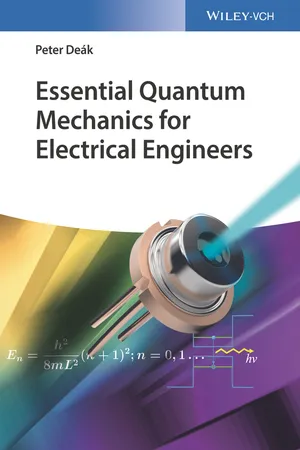
- English
- ePUB (mobile friendly)
- Available on iOS & Android
Essential Quantum Mechanics for Electrical Engineers
About This Book
Quantum mechanics (QM) is latently present in the life of electrical engineers already, since the hardware of todays information technology - from electrical data processing, through interconversion of electronic and optical information, to data storage and visualization - works on QM principles. New developments in micro- and opto-electronics and the advent of quantum information processing will soon make the active understanding of QM unavoidable for engineers, too. Unfortunately, the principles of QM can only be formulated mathematically, so even introductory books on the subject are mostly rather abstract. This book, written mainly for BSc students, tries to help the reader by showing "QM in action", demonstrating its surprising effects directly in applications, like lighting technology, lasers, photo- and solar cells, flash memories and quantum bits. While the axioms and basic concepts of quantum mechanics are introduced without compromises, the math is kept at a level which is required from electrical engineers anyhow. Computational work is spared by the use of Applets which also visualize the results. Among the host of other didactic features are learning objectives, chapter summaries, self-testing questions, and problems with solutions, while two appendices summarize the knowledge in classical physics and mathematics which is needed for this book.
Frequently asked questions
Information
Chapter 1
Introduction: Classical Physics and the Physics of Information Technology
This chapter…
1.1 The Perception of Matter in Classical Physics: Particles and Waves






| Particles | First generation | Second generation | Third generation |
| Quarks | Up (u) | Charm (C) | Top (t) |
| Down (d) | Strange (S) | Bottom (b) | |
| Leptons | Electron (e) | Muon (μ) | Tau (τ) |
| e-Neutrino | μ-Neutrino | τ-Neutrino |
1.2 Axioms of Classical Physics

Table of contents
- Cover
- Title Page
- Copyright
- Dedication
- Table of Contents
- Preface
- Chapter 1: Introduction: Classical Physics and the Physics of Information Technology
- Chapter 2: Blackbody Radiation: The Physics of the Light Bulb and of the Pyrometer
- Chapter 3: Photons: The Physics of Lasers
- Chapter 4: Electrons: The Physics of the Discharge Lamps
- Chapter 5: The Particle Concept of Quantum Mechanics
- Chapter 6: Measurement in Quantum Mechanics. Postulates 1–3
- Chapter 7: Observables in Quantum Mechanics. Postulates 4 and 5. The Relation of Classical and Quantum Mechanics
- Chapter 8: Quantum Mechanical States
- Chapter 9: The Quantum Well: the Basis of Modern Light-Emitting Diodes (LEDs)
- Chapter 10: The Tunnel Effect and Its Role in Electronics
- Chapter 11: The Hydrogen Atom. Quantum Numbers. Electron Spin
- Chapter 12: Quantum Mechanics of Many-Body Systems (Postulates 6 and 7). The Chemical Properties of Atoms. Quantum Information Processing
- Appendix A: Important Formulas of Classical Physics
- Appendix B: Important Mathematical Formulas
- Appendix C: List of Abbreviations
- Solutions
- Index
- End User License Agreement